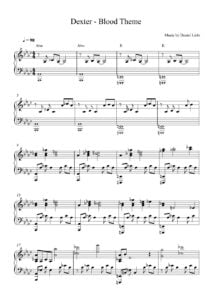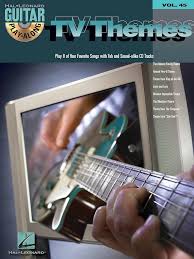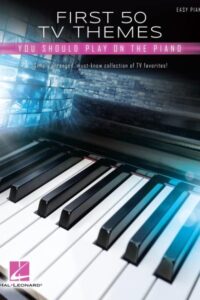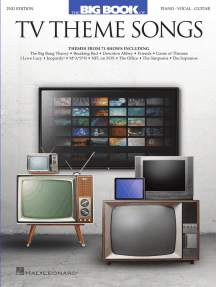Table of Contents
Come join us now, and enjoy playing your beloved music and browse through great scores of every level and styles!
Can’t find the songbook you’re looking for? Please, email us at: sheetmusiclibrarypdf@gmail.com We’d like to help you!
Daniel Licht: Architect of Sonic Shadows – A Comprehensive Exploration

Please, subscribe to our Library.
If you are already a subscriber, please, check our NEW SCORES’ page every month for new sheet music. THANK YOU!
Daniel Licht: Architect of Sonic Shadows – A Comprehensive Exploration
Daniel Licht (1957-2017) was far more than just the composer behind Showtime’s iconic serial killer drama Dexter. He was a sonic chameleon, a master of evocative minimalism, and a craftsman who thrived in the shadows of psychological tension, dark humor, and the macabre. His career spanned decades, weaving through experimental rock, dark cabaret, video games, and ultimately, a defining legacy in film and television scoring, particularly within the horror and thriller genres. This extensive exploration delves into his life, musical language, influences, enduring legacy, and vast body of work.

Best Sheet Music download from our Library.
I. Biography: From Boston to the Dark Side of the Screen
Born on March 13, 1957, in Boston, Massachusetts, Daniel Licht’s musical journey began early. He studied composition and piano at Hampshire College in Amherst, Massachusetts, immersing himself in a diverse range of influences. His early career wasn’t confined to the scoring stage; it pulsed with the energy of live performance and alternative music.
- The Band Years & Experimental Roots: Before composing for screens, Licht was a vital member of the Boston-based experimental rock band Dinner Music. Active primarily in the 1980s and early 90s, the band carved a niche with its darkly theatrical, often satirical, and musically adventurous sound. Licht played keyboards, accordion, and contributed significantly to their songwriting. Dinner Music released albums like Dinner Music (1985) and Bone (1990), showcasing Licht’s penchant for unconventional textures, rhythmic drive, and a blend of acoustic and electronic elements – hallmarks that would later define his scoring style. This period was crucial, honing his skills in creating atmosphere, narrative through sound, and embracing the eccentric. He also collaborated with performance artists like Karen Finley, further exploring the intersection of music, theater, and provocative subject matter.
- Transition to Film & Television: Licht’s move into scoring was organic. His ability to create compelling, often unsettling atmospheres naturally lent itself to film and TV, particularly genres exploring the fringes of human experience. He began composing for documentaries and lower-budget features in the late 80s and early 90s, gradually building a reputation for effective, intelligent horror and thriller scores. Projects like Children of the Corn II: The Final Sacrifice (1992), Children of the Corn III: Urban Harvest (1995), Stephen King’s Thinner (1996), and Hellraiser: Bloodline (1996) established him as a reliable and inventive voice within genre filmmaking. These early works already displayed his knack for melodic minimalism, rhythmic ostinatos, and blending acoustic instruments (piano, strings, woodwinds) with synthesized textures and found sounds.
- The Dexter Era & Beyond: Licht’s career reached its zenith with his groundbreaking score for Dexter (2006-2013). Showrunner Clyde Phillips specifically sought Licht, drawn to his work on Thinner and his ability to find beauty within darkness. Licht’s score became an integral character in the show – a complex, ironic, and strangely beautiful counterpoint to Dexter Morgan’s double life. The success of Dexter catapulted Licht to wider recognition and solidified his status as a master of contemporary psychological scoring. He continued to work prolifically after Dexter, scoring films like The Vatican Tapes (2015) and Sicilian Vampire (2015), and TV series including Body of Proof (2011-2013) and The Red Road (2014-2015), demonstrating remarkable versatility beyond the serial killer niche. Tragically, Licht passed away on August 2, 2017, at the age of 60, after a battle with sarcoma. His final scores, including the Dexter podcast Dexter: Early Cuts, stand as testaments to his undiminished talent.

Browse in the Library:
Or browse in the categories menus & download the Library Catalog PDF:
II. Music Style: Minimalism, Irony, and the Beauty in the Dark
Daniel Licht’s musical style defied simple categorization but possessed several defining characteristics:
- Evocative Minimalism: Licht was a master of “less is more.” He understood that silence and space were as powerful as sound. His scores often revolve around simple, repetitive melodic fragments or rhythmic cells (ostinatos) that gradually evolve and accumulate emotional weight. A single piano note, a plucked acoustic guitar string, or a sparse marimba pattern could carry immense tension or pathos. This minimalism prevented melodrama, instead fostering an unsettling intimacy and allowing the narrative and performances to breathe.
- Hybrid Textures: Licht seamlessly blended acoustic and electronic elements. Warm, organic sounds like piano, double bass, cello, clarinet, and acoustic guitar were frequently juxtaposed with cold, synthetic textures, glitches, pulses, and processed sounds. This fusion created unique sonic palettes – simultaneously familiar and alien, comforting and unsettling. It perfectly mirrored the duality of characters like Dexter Morgan (normal facade / monstrous reality) and the often-unsettling worlds he scored.
- Rhythmic Precision & Drive: Even in his most ambient moments, rhythm was fundamental. He employed driving, often complex, polyrhythmic patterns using unconventional percussion (metal objects, prepared piano, electronic beats) alongside traditional kits. This rhythmic energy provided relentless forward motion, mirroring the ticking clock of suspense or the internal drive of a protagonist. Think of the propulsive, almost industrial rhythms underscoring Dexter’s stalking sequences or the tense investigations in Body of Proof.
- Melodic Fragments & Motifs: Licht rarely wrote sweeping, traditional themes. Instead, he crafted short, memorable melodic fragments or motifs associated with specific characters, emotions, or situations. These motifs were developed through variation – changing instrumentation, rhythm, harmony, or context – creating subtle narrative arcs. Dexter’s “Blood Theme” is the prime example: a simple, haunting 4-note descending figure on piano that becomes infinitely adaptable, reflecting his calm, his kills, his guilt, and his twisted code.
- Harmonic Ambiguity & Dissonance: Licht often employed modal harmonies (Dorian, Phrygian), quartal/quintal chords (built on 4ths/5ths), and carefully placed dissonance. He wasn’t afraid of unresolved tension or chords that hovered between major and minor. This ambiguity created psychological unease and reflected the moral gray areas prevalent in his projects. He could also shift suddenly into moments of surprising consonance or beauty, creating powerful ironic contrast.
- Sonic Irony & Dark Beauty: Perhaps Licht’s most distinctive trait was his ability to find profound, often melancholic beauty within horrifying or suspenseful contexts. A delicate piano melody might underscore a brutal kill; a warm, almost romantic string passage might accompany a moment of profound deception. This sonic irony was central to Dexter‘s success but permeated much of his work. It forced the audience to confront complex emotional responses and highlighted the humanity (however twisted) within darkness.
- Use of Diegetic Sound: Licht sometimes cleverly integrated diegetic sound (sound existing within the scene’s world) into his scores. The rhythmic clinking of surgical tools, the hum of a refrigerator, or the dripping of water could become percussive elements or melodic triggers within his compositions, blurring the line between score and sound design and enhancing realism.

III. Improvisational Flair and Harmonic Language: The Craft Beneath the Surface
While Licht wasn’t primarily known as an improvising soloist in the jazz sense, his compositional process and the resulting music displayed an improvisational spirit and deep harmonic sophistication:
- Improvisation as Compositional Tool: Licht often spoke of starting with improvisation at the piano or with synthesizers to find core ideas – a rhythmic groove, a haunting chord progression, a simple melodic cell. The iconic “Blood Theme” reportedly emerged this way. He would then refine, structure, and orchestrate these raw ideas. Performers on his scores, particularly solo instrumentalists, were often given room for expressive interpretation within his frameworks, adding subtle improvised nuances to melodic lines, especially on instruments like double bass or clarinet.
- “Licks” as Motivic Development: Licht’s “licks” weren’t flashy guitar solos but rather signature motivic gestures that permeated his scores. These included:
- The Descending Minor Line: The core of the “Blood Theme” (E-D-C#-B in various keys). This simple, mournful descent appears in countless variations across his work.
- Piano Figurations: Repetitive, often slightly dissonant arpeggios or clusters creating tension or unease. Sparse, high-register single notes or octaves creating isolation. Rhythmic stabs using the piano’s percussive nature.
- Pizzicato/String Scrapes: Sharp, plucked string sounds (pizzicato) or harsh bow scrapes used percussively or for sudden stings.
- Electronic Pulses & Glitches: Rhythmic electronic pulses, distorted glitches, or manipulated samples adding a modern, often unsettling edge.
- Woodwind Sighs: Breath-like phrases from clarinet or bass clarinet, adding a human, often melancholic or eerie quality.
- Chord Progressions and Harmony:
- Modal Foundation: Licht frequently used modal scales, particularly Dorian (minor with raised 6th – evokes mystery, melancholy) and Phrygian (minor with flattened 2nd – evokes tension, exoticism, unease). The “Blood Theme” itself is often perceived as Dorian.
- Ostinato Basslines: Driving, repetitive bass figures (acoustic bass, synth bass) often outlining simple intervals (4ths, 5ths, minor 2nds) or modal patterns, creating hypnotic foundations.
- Quartal/Quintal Harmony: Chords built by stacking perfect 4ths or 5ths (e.g., C-F-Bb or C-G-D) instead of traditional thirds. These create open, ambiguous, slightly unresolved sonorities perfect for suspense. Licht used these extensively.
- Suspensions and Added Tones: Adding dissonant notes (2nds, 7ths, 9ths, 11ths) to chords and delaying their resolution created constant tension.
- Pedal Points: Sustained notes (often low drones) over which harmonies shift, creating a sense of grounding amidst instability.
- Minor Key Dominance with Shifts: While minor keys prevailed, Licht masterfully shifted to relative major, parallel major, or other unexpected keys for moments of ironic beauty, false hope, or unsettling calm.
- Cluster Chords & Dissonance: Carefully placed dissonant clusters (groups of closely spaced notes) for shock, horror, or intense psychological pressure. He used them sparingly but effectively.

IV. Influences: A Tapestry of Sound
Licht’s unique voice emerged from a diverse range of influences:
- Minimalist Composers: Steve Reich (phasing, rhythmic patterns), Philip Glass (repetitive structures, arpeggios), Terry Riley (drones, modal exploration). Licht absorbed their techniques but applied them to narrative, often darker contexts.
- Film Composers: Bernard Herrmann (psychological tension, innovative orchestration for Hitchcock), Ennio Morricone (melodic minimalism, evocative use of simple motifs, eclectic instrumentation), John Carpenter (minimalist synth scores, driving rhythms, creating atmosphere with limited means), Angelo Badalamenti (Lynchian dreaminess/dread, use of jazz elements in dark settings).
- Jazz: Thelonious Monk (dissonance, angular melodies, rhythmic surprise), Miles Davis (modal jazz, atmospheric textures, especially In a Silent Way/Bitches Brew era), Charles Mingus (expressive bass, complex rhythms, raw emotion). Jazz influenced his harmonic language, rhythmic complexity, and the space for individual instrumental expression.
- Rock & Alternative: His years with Dinner Music and general immersion in the 80s/90s alternative scene influenced his willingness to experiment, use electronic sounds aggressively, embrace rhythmic drive, and incorporate rock instrumentation (distorted guitar appears occasionally).
- World Music: Percussive textures, unusual scales, and drone-based elements sometimes hinted at broader global influences, integrated subtly into his hybrid style.
- Avant-Garde & Experimental: His work with Karen Finley and Dinner Music’s own bent placed him within an experimental tradition valuing sound exploration, texture, and challenging conventions.

V. Legacy: Echoes in the Dark
Daniel Licht’s legacy is profound and multifaceted:
- Redefining TV Horror/Thriller Scoring: Dexter changed the game. Licht proved that a score for a dark, complex show could be subtle, beautiful, ironic, and character-driven, eschewing traditional horror clichés. It prioritized psychology over shock, atmosphere over bombast. This approach influenced countless subsequent scores for psychological thrillers and character-driven horror series.
- Master of Sonic Irony: His ability to juxtapose beauty with horror, warmth with cold calculation, became a signature. He taught audiences and composers alike that music for the dark side could be emotionally complex and aesthetically rich, not merely frightening.
- Elevating Minimalism in Media: Licht demonstrated the immense power of restraint. His scores proved that minimalism, when applied with narrative intelligence, could be more effective than large-scale orchestral grandeur in creating tension, intimacy, and psychological depth.
- Hybrid Textures as Standard: His seamless blending of acoustic and electronic elements became a blueprint for modern suspense, horror, and thriller scoring. Composers across film and TV now regularly employ this hybrid approach as a primary tool.
- The Enduring Power of the Motif: The “Blood Theme” stands as one of the most recognizable and thematically potent motifs in television history. It exemplifies how a simple, well-crafted musical idea, developed intelligently, can become synonymous with a character and a show.
- Influence on a Generation: Composers working in dark genres today, from Bear McCreary to Mac Quayle to Natalie Holt, show traces of Licht’s influence in their use of minimalism, hybrid textures, rhythmic drive, and psychological complexity.
VI. Major Works & Filmography (Selective)
Licht’s output was vast. Here’s a selection highlighting key projects:
- Television:
- Dexter (2006-2013, 2015 podcast, 2021 revival) – Defining work.
- Body of Proof (2011-2013) – Procedural drama showcasing versatility, blending mystery with character moments.
- The Red Road (2014-2015) – Atmospheric, tension-filled score for the SundanceTV drama.
- Kingdom Hospital (2004) – Stephen King miniseries, early example of his atmospheric horror work.
- Sleepwalkers (1997) – Cult horror series.
- Fear Itself (2008) – Horror anthology series (episodes).
- Perception (2012-2015) – Crime drama with a neurodiverse protagonist.
- Film:
- Stephen King’s Thinner (1996) – Early standout horror score, showcasing his darkly effective style.
- Hellraiser: Bloodline (1996) – Inventive score for the franchise’s space-set entry.
- Children of the Corn II: The Final Sacrifice (1992) / III: Urban Harvest (1995) / 666: Isaac’s Return (1999) – Established his genre credentials.
- Bleeders (1997) / The Terrorist (1997) – More atmospheric horror.
- The Vatican Tapes (2015) – Later exorcism-themed horror showcasing refined style.
- Sicilian Vampire (2015) – Dark comedy/horror.
- Amnesiac (2014) – Psychological thriller.
- The Perfect Witness (2007) – Thriller.
- Video Games:
- Silent Hill: Book of Memories (2012) – Contributed to the iconic horror franchise’s soundscape.
- Dishonored (2012) – Composed the main theme and additional music for the acclaimed steampunk action game, fitting its dark, atmospheric world perfectly.
- Fallout: New Vegas (2010) – Contributed ambient tracks to the post-apocalyptic RPG.
- Ripper (1996) – Early CD-ROM game.
- Documentaries:
- Numerous projects throughout his career.
VII. Discography (Selective – Film/TV Scores & Band Work)
- With Dinner Music:
- Dinner Music (1985)
- Bone (1990)
- Soundtrack Albums:
- Dexter: Music From The Showtime Original Series (2007)
- Dexter: Season 2 (2008)
- Dexter: Season 3 (2009)
- Dexter: Season 4 (2010)
- Dexter: Season 5 (2011)
- Dexter: Season 6 (2012)
- Dexter: Season 7 & 8 (2013) – Often combined release.
- Dexter: Original Mondo Score (2013) – Vinyl release of key themes.
- Stephen King’s Thinner (1996) – Promo release.
- Hellraiser: Bloodline (1996) – Promo release.
- Children of the Corn III: Urban Harvest (1995) – Promo release.
- Body of Proof (2013) – Digital release.
- The Vatican Tapes (2015)
- Dishonored (Official Game Soundtrack – includes Licht’s main theme) (2012)
- Silent Hill: Book of Memories (2012)
- (Note: Many early scores exist only as isolated promo CDs or within the films themselves).
VIII. Most Known Compositions and Performances
- The “Blood Theme” (Dexter): Undoubtedly his most iconic creation. The simple, haunting 4-note descending piano motif. Its countless variations throughout the series represent the pinnacle of his minimalist, character-driven, and ironically beautiful approach. Performed primarily by Licht himself on piano, often layered with subtle electronic textures or solo strings/cello.
- “Dexter Main Title”: A brilliant encapsulation of the show’s tone. Combines the “Blood Theme” with driving, precise rhythms (mimicking Dexter’s morning routine), sharp electronic stabs, processed sounds (like the mosquito buzz), and moments of darkly beautiful harmony. It’s a mini-masterpiece of narrative scoring.
- “House Theme” (Dexter): Often a warmer, slightly melancholic variation on the Blood Theme using guitar or strings, representing Dexter’s facade and his connection (however flawed) to his home and family.
- “Kill Theme” (Dexter): Variations on the Blood Theme incorporating more intense rhythmic drive, lower registers, dissonant clusters, or electronic pulses, underscoring the act of killing or intense stalking sequences.
- “Deb’s Theme” (Dexter): A more lyrical, emotionally resonant theme often featuring strings or piano, reflecting Dexter’s complex love for his sister and the tragedy surrounding her.
- Main Theme (Dishonored): A darkly atmospheric, slightly mournful piece combining acoustic guitar, deep strings, and subtle electronics, perfectly capturing the game’s steampunk dystopia and Corvo’s quest.
- Thinner Main Theme: An early example of his effective horror scoring, using rhythmic percussion, dissonant strings, and a simple, unsettling melodic idea.
- Hellraiser: Bloodline Score: Notable for its blend of orchestral horror tropes with Licht’s emerging minimalist and electronic tendencies, particularly in the space-bound sections.
Daniel Licht: The Lingering Resonance
Daniel Licht was a unique and vital voice in contemporary music. He transcended genre limitations, finding profound emotional depth and sonic beauty within the darkest corners of the human psyche. His legacy rests not just on the cultural phenomenon of Dexter, but on a consistent body of work that redefined suspense, horror, and thriller scoring through masterful minimalism, innovative hybrid textures, rhythmic ingenuity, and a fearless embrace of sonic irony. He understood that the most potent musical statements about darkness are often whispered, not screamed; that a single, perfectly placed piano note can carry the weight of a monster’s soul; and that beauty, even when twisted, remains a powerful force. Licht’s music continues to resonate, a testament to his skill in crafting sonic shadows that linger long after the screen fades to black. He remains an essential architect of the modern soundscape of psychological tension.
Daniel Licht Works
Browse in the Library:
Or browse in the categories menus & download the Library Catalog PDF:
